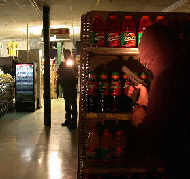|
Course Description
 This course is an 8-hour academic program,
the entirety
of which is taught in a seminar format, within the confines of a
classroom. This course is an 8-hour academic program,
the entirety
of which is taught in a seminar format, within the confines of a
classroom.
This class is structured to assist patrol officers, both new and
veteran, in methods that will assist them in managing a diverse range of
occupational risks associated with
shift-work. Attendees will also learn how to
mitigate those occupational risks specifically related to working under
diminished light conditions.
Although the course follows a seminar structure, complimented with
extensive audio-visual materials, it affords student-instructor
interactivity that enables the program to offer even greater value to
attendees.
Course Learning
Objectives
Upon
completion of this course, participants:
-
Will know the
occupational safety problems associated with working shift-work.
-
Will understand the
nature of circadian rhythms and how they impact performance.
-
Will understand concepts
pertinent to work-load scheduling.
-
Will know the short,
medium and long-term health ramifications of shift-work.
-
Will know the value of
napping as a fatigue countermeasure tactic.
-
Will know when and how
to employ “activity breaks” to boost alertness during night shifts.
-
Will know what dietary
guidelines to follow to diminish performance-robbing insulin spikes
on night shifts.
-
Will know the nature and
trade-offs of caffeine as a nightshift stimulant.
-
Will understand the
importance of timing and dosage when using caffeine as a fatigue
countermeasure.
-
Will know how to
maximize quality sleep when off-duty.
-
Will know how and to
what extent that vision is impaired at night.
-
Will know how threat
discrimination is influenced by diminished lighting.
-
Will know the frequency
of mistake-of-fact shootings under low light conditions.
-
Will understand the
limitations and effective parameters of flashlight and patrol
vehicle lighting.
-
Will know the night-time
advantages and disadvantages of certain vehicle stop techniques.
-
Will understand the
applied differences between target acquisition devices and
illumination devices.
-
Will know what
flashlight selection criteria are most important.
-
Will know the most
intuitive techniques for employing flashlights, and when to employ
them with greater caution.
-
Will know why ambient
light measurement is such a critical element of officer-involved
shootings.
-
Will know the effective
parameters and selection criteria of night vision devices (NVDs).
-
Will understand uniform
and equipment considerations for shift-workers.
-
Will know specific
training considerations that should be addressed for shift-workers.
Click Here for a printable PDF brochure
for this course.
Course Instructor:
Thomas J. Aveni,
MSFP
Tom Aveni has been a career law enforcement officer, having
served on the local and state levels in three states (NJ, UT, NH). His
police career began in 1978, and he has served as a police trainer since
1983. From 1990 to 2001 Tom served as a police "Training Coordinator"
with the once prestigious Smith & Wesson Academy. There he was
instrumental in training over 12,000 police and military personnel from
across the United States and 23 other countries.
Mr. Aveni achieved his undergraduate degrees in Criminal Justice while
minoring in psychology. He received his Master’s Degree in Forensic
Psychology from American International College, Springfield, MA.
Since 1996, Mr. Aveni's police training focus became oriented
toward researching so-called “questionable” police shootings. These
shootings routinely involve suspects who were unarmed and non-assaultive
when shot by police. Previous studies had suggested that 25-43% of
police shootings are of unarmed suspects. In this pursuit, Tom also
examined the influence of police bias and contextual expectations on the
inclination to use deadly force.
Tom's research into "questionable" police shootings contributed
to the creation and advancement of the first (1995) and
most
comprehensive low light instructor training program ever offered. By
1998, Tom's low light instructor training was being taught
internationally.
Mr. Aveni lectures nationally, presenting a variety of
instructor-level courses. Tom has also been a frequent contributor to
several law enforcement publications, such as Law & Order Magazine,
Police & Security News, The Trainer, and others. He is co-author of a
soon-to-be published text, “Surviving the Nightshift®.”
|
Length |
1 day/ 8 hours |
|
Tuition |
$175 |
|
Dates |
(See
Schedule
or
Course Hosting) |
|
Location |
Please call 877-267-7772 ext. 3 |
Please Note: All
applications, tuition or POs must be received prior to the beginning of
class. Tuition includes a comprehensive classroom manual and all
classroom materials. Tuition does NOT include the cost of the ammunition
that each student will consume.
Eligible candidates for this
program are members of the police, corrections, military and security
communities. ALL applicants MUST provide credentials of their
affiliation with an accredited law enforcement, corrections, military or
security organization for acceptance into this program.
Refunds are allowable provided that customers comply with the following stipulations:
-
100% refund: permissible if course withdrawal is no less than 30 days of the starting date of the course you've enrolled in.
-
50% refund: is afforded if withdrawal is requested within 30 days of your course starting date, but not less than 7 days of that starting date.
Exceptional Circumstances
Refund:
May be granted if the above
stipulations are not met, but when emergency circumstances
(i.e., professional or personal) might apply. These will be
judged for merit on an individual basis.
|

